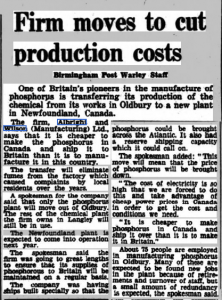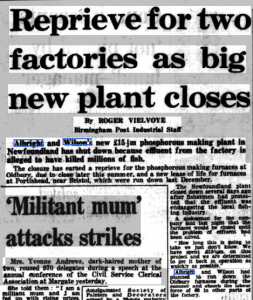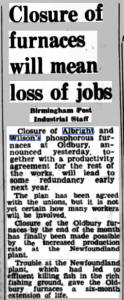The rocketing production of white phosphorus in the first half of the century is shown in Hugh Podger’s book. Employing the 6 refitted furnaces- “The output of the Oldbury plant in 1949 was about 6,000 tons, raised by 1951 to more than 10,000 tons and subsequently to more than 12,000 tons, close to their theoretical capacity.”
Subsequent estimates of phosphorus production can be sourced from non Albright and Wilson sources. An article from The Times from Wednesday July 11 1956 stated
“Phosphorus production in the United Kingdom is about 60 million lb a year, and about 6-7kw of electricity are needed to produce each pound of phosphorus. The United kingdom makes about 10 per cent. of phosphorus production this side of the iron curtain.”
Another source of information comes from a competitive analysis report produced by I.C.I in 1960 . This can be viewed below.
Albright and WIlson competitive analysis by ICI in 1960
Page 5 of this document makes the key statement
“Albright & Wilson, the only manufacturers of phosphorus in Britain, convert a substantial part of their output of 40,000 tons a year to non-agricultural phosphates, the demand for which (particularly from the detergent industry) has increased rapidly since the war
To meet this demand they completed new factories (doubling their capacity) at Portishead and Kirkby in 1954; and in 1955 they further strengthened their position by purchasing Marchon Products Ltd., the only other British manufacturer of detergent phosphates. In February 1960 they successfully bid for the capital of A. Boake, Roberts & Co.(Holding) Ltd makers of phosphate and phthalate plasticizers and other chemicals; but only the financial aspect of the merger is covered in this report.”
Page 5 also notes
“At Oldbury and Portishead, Albright & Wilson extract some 40,000 tons a year of phosphorus from rock phosphate by electrothermal reduction with carbon in presence of silica .”
Page 22 comments
“General Chemicals Division have estimated that in 1958 Albright & Wilson produced more than 36,000 tons* of elemental phosphorus, of which half came from Portishead, nearly half from Oldbury, and the balance from the Widnes furnaces (since closed down). The current output is probably 40,000 tons a year.”
It continues
“Under the protection of K.I.D, they have increased the output of these plants threefold in the last ten years and now supply there from all the phosphorus consumed in this country….
Phosphorus is normally produced in the white or yellow form, which, in small quantities, is supplied as solid sticks immersed in water, but if required in bulk, can now be delivered as liquid in heat-insulated tanks. For match making, however, white phosphorus must be converted to the amorphous, or red, allotropic modification, which is less reactive and non-poisonous.”
An explanation of the term “K.I.D” is also given in the report indicating the British Governments subsidy of their former agency factory, whose ties never seemed to lessen post war.
“Key Industries Duty: a supplementary tariff protection formerly granted to producers in Britain or the Commonwealth who guaranteed to make 80 per cent. of this country’s requirements of strategically important materials. It has now been superceeded by the terms of the Import Duties Act of 1958.”
Article from October 1968’s Albright World showing one of the main raw materials for P4 production, a huge stock pile of silica chippings as well as barrels, electrical equipment and valves. We have looked at the historic methods of production of p4 at Oldbury HERE.
END OF THE LINE FOR OLDBURY WHITE PHOSPHORUS
The Birmingham Daily Post of 19th February 1964 stated that P4 production would move to Portishead and that the furnaces would be progressively shut down over the next two years.
In fact, the blight it caused, and the effluent pollution would continue for a few years more.
The demise of direct white phosphorus production at Oldbury and at their other production plant at Portishead was sealed with the opening of their Long Harbour plant in Newfoundland, a raw material production cost cutting decision.
The Birmingham Daily Post of 15th September 1967

“The transfer will eliminate fumes from the factory which caused complaints by local residents over the years.”
This in itself would eventually close down after many early disastrous public relations episodes involving pollution in Placentia Bay, which arguably led to the demise of the entire company. Long Harbour’s failures would extend Oldbury’s pain. The Birmingham Post again broke the “good” news. 
The Birmingham Daily Post of 3rd December 1969 gives the news that the furnaces were finally going to shut down, much to the “welcome” relief of local residents, for so long living in the shadow and smell of Albright and Wilson’s money making venture. The best quote comes from a Mr R. Steele who notes
“The smells in the area have at times been unbearable. This had been going on for several years, and I am sure that local residents will be glad that the plant is closing”
According to Albright magazine February 1970, which laments the final shutting down of the large white phosphorus producing furnace, after World War 2 “…phosphorus was not produced again at Oldbury until 1946 and, in the following 6 years, production expanded rapidly. Between the end of the war and the close-down last year, Oldbury had produced 527,000,000 lbs of phosphorus.”
This is an incredible quantity, (239,043,194 kg), and undoubtedly the waste stream, before any regulation took place would have seen it containing an equally large contamination of white phosphorus within it.
An idolating foreman laments the demise of the source of Albright and Wilson’s pollution.
Though raw production of white phosphorus in the furnaces may have stopped in 1970, its manufacture obviously restarted after the disastrous Long Harbour failure. Its use at Oldbury has continued throughout to the present day, through the Rhodia era and now the Solvay name change. The dismantling of the furnace and its contaminated pieces of plant shown above, as well as the heavily contaminated ground around it obviously would have had to be disposed of.
In an account of the dismantling, the articles author laments “Now the furnaces are being demolished, the building pulled down. The noise and acrid smell will be no more… odd workmen passed to- and- fro armed with crowbars and barrows, carrying pieces of the once proud furnaces- pipes, fire-doors, valves and chains.”
NO DOUBT THEY WENT TO A WATERY GRAVE AT A CONVENIENT LOCAL WASTE DISPOSAL SITE THAT THE COMPANY OWNED .
Hugh Podger laments on the AW slide , “Perhaps the key failing was hubris (defined as arrogance inviting disaster), born of the history of the previous 100 years.”
Unfortunately Hubris is a concept which continued to dog the works management of this company long after it had ceased to exist in name.








